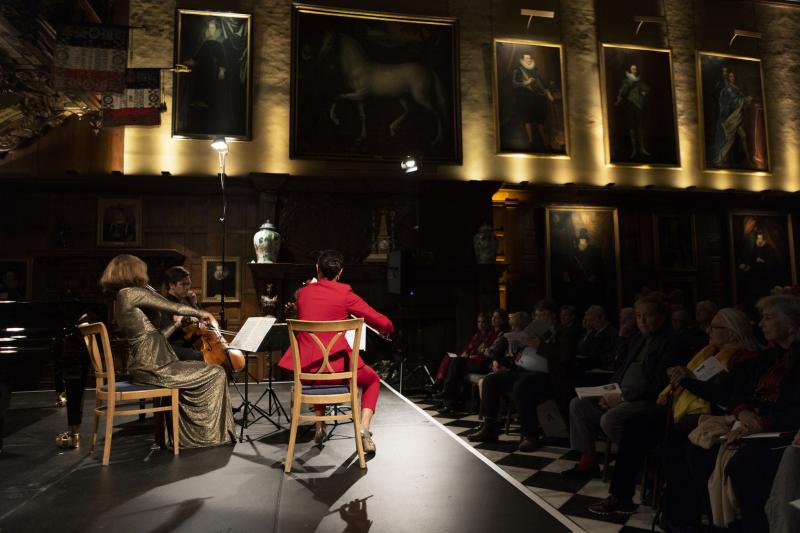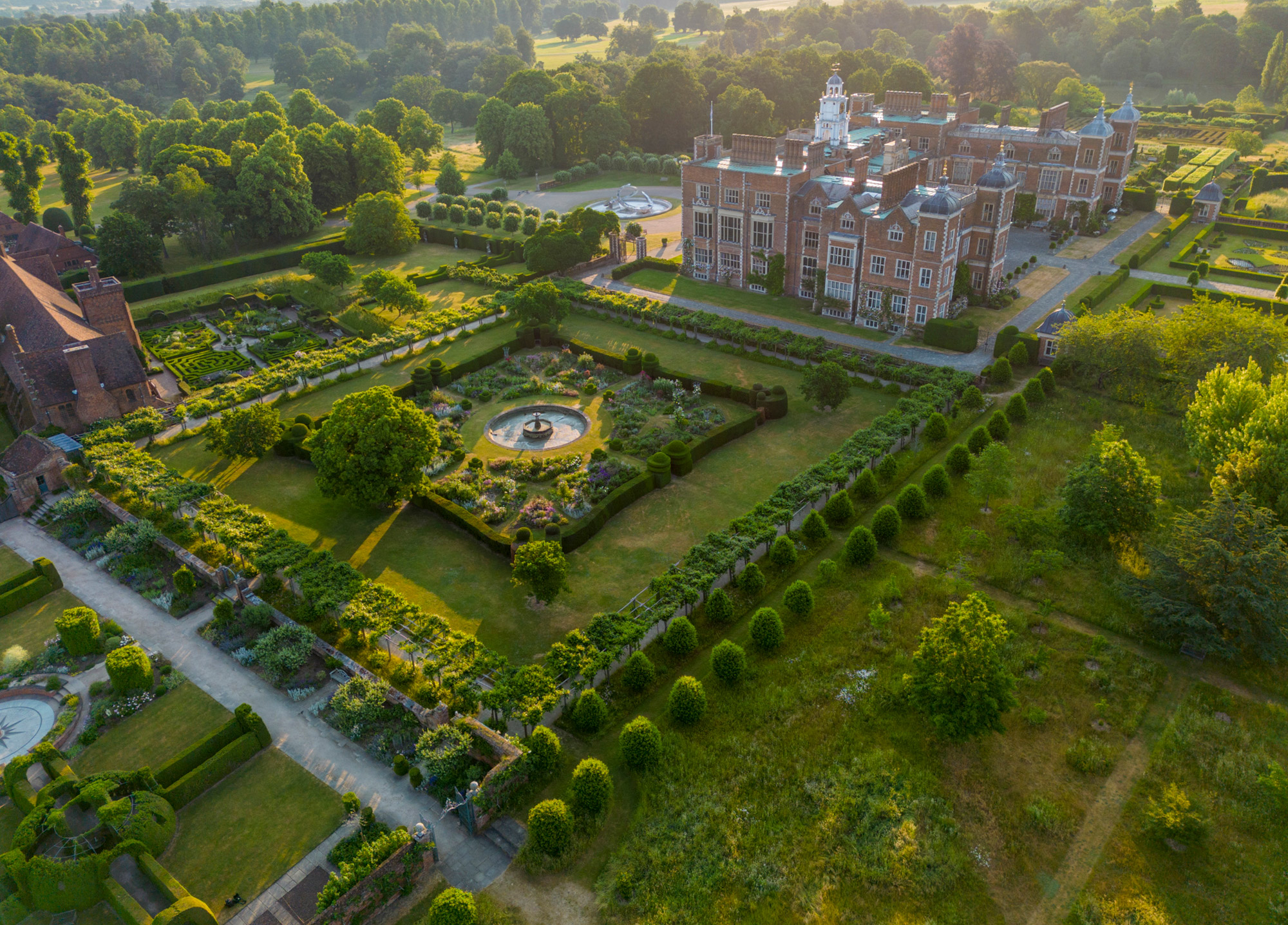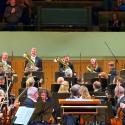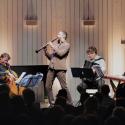“Sero sed serio”: so runs the Salisbury family motto on the carved coat-of-arms in the lavishly panelled and painted Marble Hall of Hatfield House. “Late, but in earnest”. The first adjective certainly doesn’t apply to any member of the Kaleidoscope Chamber Collective, five of whom performed in the Hall for one of the centrepiece events of the 13th Hatfield House Music Festival.
The Collective, founded by violinist Elena Urioste and pianist Tom Poster in 2017, hosts a flexible roster of instrumental partners equipped to deliver small-ensemble pieces across a spectrum of different configurations. They run an admirably tight ship, mutually attentive and alert whatever the shape of the group: no late entries here. But, however serious, their music-making never feels too earnest, with a sense of collaborative, even conspiratorial, spritz and fun in evidence across their work.
With high-quality events staged against a supremely photogenic backdrop – especially, as on Saturday, on a brightly moonlit autumn night – the well-established Hatfield festival should perhaps attract more critical fuss than it presently does. It may be that having a venue sited almost in Londoners’ backyard (less than half an hour from King’s Cross) oddly limits its allure. No matter: the Kaleidoscope quintet graced the spectacular setting, dominated by the newly-restored “Rainbow” portrait of Elizabeth I, with a programme that showcased not only agility and versatility but a consistent freshness and verve in their performing style. Poster and Urioste were joined by the cellist, and Hatfield festival artistic director, Guy Johnston, the violist Rosalind Ventris, and the oboist Armand Dijkoloum. In the Collective's trademark manner, they layered a lesser-known chamber piece – the 1908 piano quartet by Croatian composer Dora Pejačević – between more familiar fare: Mozart’s oboe quartet and Dvořák’s own piano quartet, with a side-dish of Schumann’s three romances for oboe and piano.  The vigilant togetherness of proper ensemble playing – underpinned by Poster’s prominent, but never over-dominant, piano – lent drive and bite to each piece. Hallowed aristocratic halls don’t always do acoustic justice to small groups (to say the least), but Hatfield’s Jacobean panelling did the job in terms of warmth and clarity. In the Mozart, Dijkoloum’s oboe at times felt slightly at odds with the trio of strings – but then the work itself sporadically shifts into a soloistic, concertante mode. For me, his upper-register excursions – written in 1781 to show off the newly-improved instrument’s range – proved less compelling that the fine dark sorrow of the oboe’s lower depths, especially in the serene wordless aria of the adagio. Urioste, Ventris and Johnston made the string writing sing sweetly and boldly, while in the finale Dijkoloum deftly sailed through a bravura passage when, rhythmically, the oboe seems to play not with but directly against other parts.
The vigilant togetherness of proper ensemble playing – underpinned by Poster’s prominent, but never over-dominant, piano – lent drive and bite to each piece. Hallowed aristocratic halls don’t always do acoustic justice to small groups (to say the least), but Hatfield’s Jacobean panelling did the job in terms of warmth and clarity. In the Mozart, Dijkoloum’s oboe at times felt slightly at odds with the trio of strings – but then the work itself sporadically shifts into a soloistic, concertante mode. For me, his upper-register excursions – written in 1781 to show off the newly-improved instrument’s range – proved less compelling that the fine dark sorrow of the oboe’s lower depths, especially in the serene wordless aria of the adagio. Urioste, Ventris and Johnston made the string writing sing sweetly and boldly, while in the finale Dijkoloum deftly sailed through a bravura passage when, rhythmically, the oboe seems to play not with but directly against other parts.
Big-boned, full-voiced, Pejačević’s quartet is no delicate salon sketch but a richly imagined development of a Brahmsian chamber idiom into a personal vein both more vernacular, and more idiosyncratic. A bracingly dramatic allegro saw restless, liquid string playing in lyrical but strenuous dialogue with Poster’s piano. If the quartet sometimes salutes the urbane harmonic panache of (say) Saint-Saëns, it also channels a more earthy and rugged mood.
In the striking adagio, Urioste’s violin theme introduces an almost folksy charm, extended by viola and cello: it’s both homely and sophisticated, and was ravishingly played. By the time we reach the bouncing, galloping “allegro comodo" finale, the piece feels not far from the boisterous pace and bold primary colours of a Dvořák furiant dance, enhanced by deft pizzicato passages but still inflected with Pejačević’s special accents. Perhaps, in compositional terms, the quartet doesn’t end quite as grippingly as it begins, but the Kaleidoscopes throughout made a thrillingly committed case for a highly attractive work.  In Schumann’s trio of tender but shadowed romances, Dijkoloum’s oboe found the communicative voice that had sometimes eluded him in the Mozart. Simple on the surface, turbulent beneath, these pieces call for soul rather than swagger. Dijkoloum’s mellow yearning tone gave an elegiac colouring to the most artlessly charming of melodies. After which, the Dvořák quartet exploded in the tense, pulsating opening dialogue of impatient piano and unison strings. Poster’s interaction with his comrades/rivals lent an edge to every exchange, even when Ventris’s viola – then Johnston’s cello – arrived with their soothing lyric balm. Fully “con fuoco” as marked, the first movement crackled with tension right down to the eerie string tremolando that precedes its crashing climax.
In Schumann’s trio of tender but shadowed romances, Dijkoloum’s oboe found the communicative voice that had sometimes eluded him in the Mozart. Simple on the surface, turbulent beneath, these pieces call for soul rather than swagger. Dijkoloum’s mellow yearning tone gave an elegiac colouring to the most artlessly charming of melodies. After which, the Dvořák quartet exploded in the tense, pulsating opening dialogue of impatient piano and unison strings. Poster’s interaction with his comrades/rivals lent an edge to every exchange, even when Ventris’s viola – then Johnston’s cello – arrived with their soothing lyric balm. Fully “con fuoco” as marked, the first movement crackled with tension right down to the eerie string tremolando that precedes its crashing climax.
Respite came in the Lento, with Johnston’s fervently gorgeous theme – later taken up and adapted by violin and piano – complemented by a beautifully controlled vibrato. Brisk, skipping, emphatic but not crude, the country dances of the third movement bristled and bounced with all of Dvorak’s rhythmic audacity, including the cheeky piano that seems to imitate a tavern cimbalom.
As for the finale, the Kaleidoscopes clung closely together and forged ahead in a kind of lucid frenzy, with each swirling, galloping interaction between instruments admirably crisp and clear. Still, Ventris’s viola cut through the clamour with its soaring individual song. To cap an evening packed with musical colloquies that converted rich parts into even richer wholes, it made sense to end with an encore of one of Poster’s own super-skilful arrangements. This time it was Henry Mancini’s “Moon River”, somehow languid yet polished: yet another twist on Kaleidoscope’s ever-evolving musical patterns.















Add comment